JUST Report
SURVEY ANALYSIS: Job Numbers Continue to Lag for Women. Here’s What Americans Say Companies Should Be Doing to Bring Them Back to Work
- More Reports
- View All News & Reports on Polling
- View all JUST Reports
April 12, 2022
This report was written by JUST Director of Survey Research Jill Mizell.
The last couple of years have been especially difficult for women in the American labor force. According to an estimate from the National Women’s Law Center (NWLC), women account for about 70% of job losses in the United States since the start of the pandemic.
Progress is being made as pandemic restrictions ease across the country, including at schools, with the U.S. Bureau of Labor Statistics reporting 249,000 women joining the labor force in March, accounting for 63% of the new jobs created. That still leaves, however, 872,000 women out of the labor force compared to before the pandemic, and the NWLC estimates that it would take four straight months at the March rate for women to fully recover jobs lost. Black women have benefited the least from the Q1 recovery, but saw promising job growth in March, with the unemployment rate for Black women aged 20 and older reaching 5.5%, compared to 3.3% for total women aged 20 and older and 2.8% for white women aged 20 and older. The pandemic has also imposed additional barriers to employment to Americans with disabilities, with a non-seasonally adjusted unemployment rate of 9.7% for women aged 16-64 in March.
COVID-19 not only took women out of the workforce, it brought to light long-standing workplace inequities that make it more difficult to remain in or rejoin the labor force. Facing obstacles from persistent pay inequity (in 2022, women earn 82 cents for every dollar earned by men) to limited access to quality, affordable child care despite the expectation that they hold the lion’s share of caregiving responsibilities, women are hampered in their efforts not only to return to work but to achieve an equitable economy that fairly supports their needs.
In an effort to better understand how Americans view these ongoing challenges, in late March JUST collaborated with research partner SSRS to survey a representative sample of 1,029 U.S. adults about what companies can do to support women’s return to the labor force. Here’s what we learned:
Key Findings
- Majorities of Americans say the inequities that women face in the workplace – from workplace harassment (76%) to pay equity (70%) – are a problem.
- Companies can do more to advance women’s equality, including implementing policies to provide a safe process for reporting harassment at work (92%) and providing equal opportunities for advancement (85%).
- Majorities agree that women leaving the workforce is bad for the economy (66%), and bad for women’s equality (59%).
- Companies can do more to retain their female employees, including prioritizing equal pay for equal work (55%), providing access to child care (47%), paying a living wage (39%), and implementing flexible work schedules (39%).
Persistent Inequities for Women at Work
Majorities of Americans acknowledge a range of problems that continue to plague women in the workforce, with three-quarters (76%) acknowledging that access to childcare and workplace harassment are problematic. The gender wage gap (70%), equal opportunities for advancement (66%), and access to paid family leave (62%) were also cited as problems.
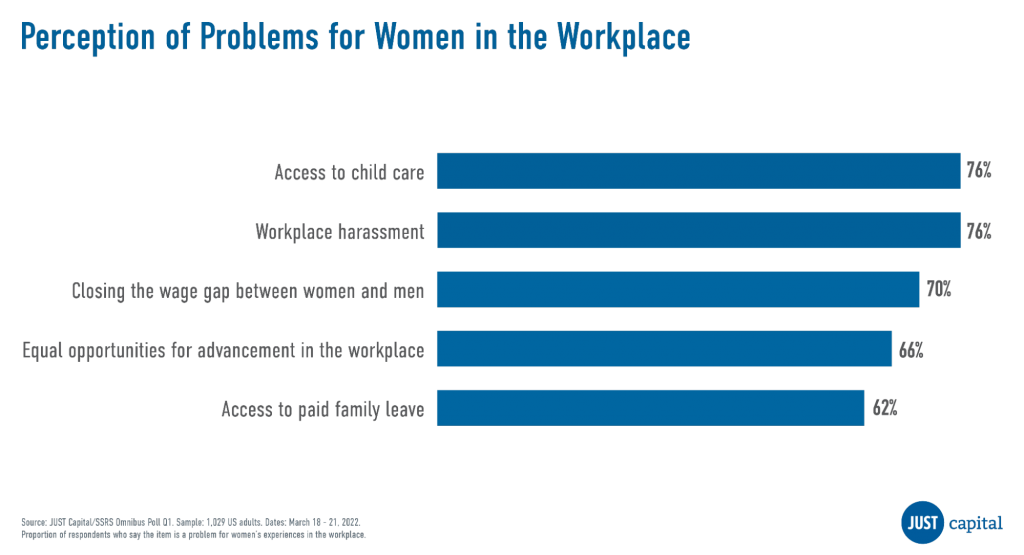
Among those that say these issues are a problem for women in the workplace, 59% say closing the wage gap between men and women and access to childcare are big problems. Nearly the same amount (54%) said the same about access to paid family leave.
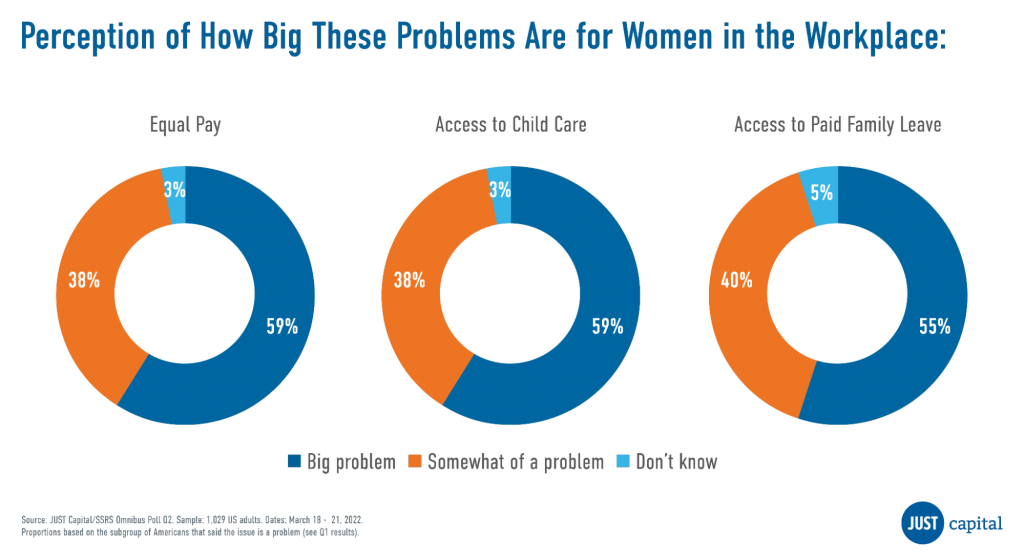
Companies Can Take Steps to Foster Gender Equality
The gender pay gap has narrowed only slightly over three decades. This is one key area in which companies can make a positive, immediate impact to foster gender equality in the workplace, and Americans agree this issue needs immediate attention:

In addition to prioritizing pay parity, majorities of Americans believe it is necessary for companies to provide a safe process for reporting harassment (92%), provide equal opportunities for advancement (85%), provide education and training programs (68%), and provide all workers a minimum of 12 weeks paid parental leave (64%).
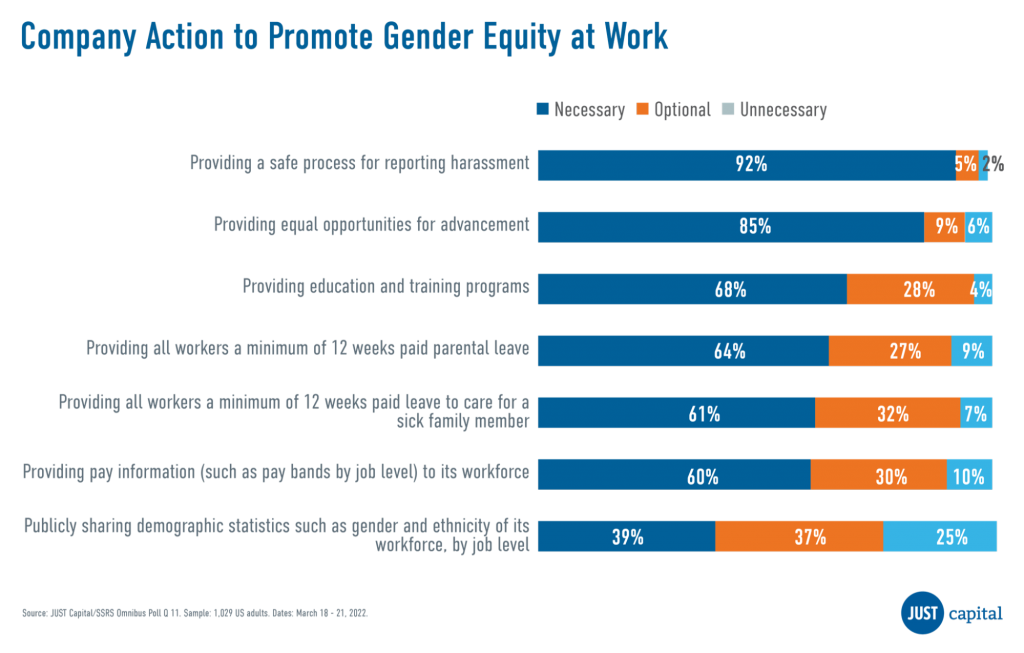
Other steps that companies can take to promote gender equity include executing pay analyses and making pay band information available to employees. Fewer say that publicly disclosing workforce demographics is necessary than the other actions, but pluralities agree this is still a key way companies can increase equity in the workplace.
Women’s Declining Participation in the Workforce
While data from February’s report showed more encouraging numbers than seen in previous months, women are still lagging behind men in economic recovery. A sizable majority of Americans believe this will have negative impacts on both the economy overall (66%) and on women’s equality in the workplace (59%).
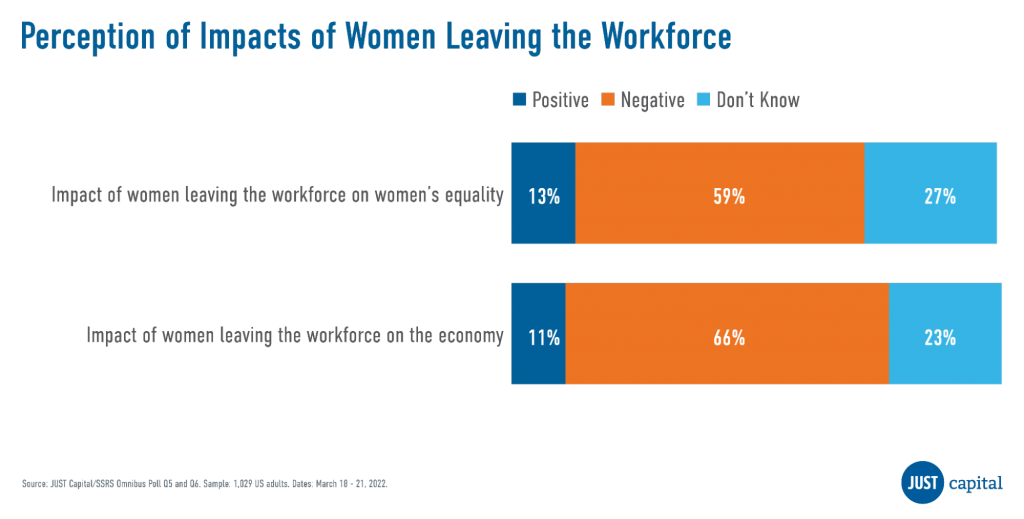
A recent poll from Gallup showed that while pay and benefits are a top priority for getting women back in the workforce, other factors were just as important to women, mostly focusing on work-life balance and well-being. And another survey from The Harris Poll found that, when considering a job with a new employer, employees are most influenced by whether the company offers flexible work schedules.
Our polling shows similar results. Pluralities of Americans say that the most important steps companies can take to help women re-enter the workforce address the same issues they agree are women’s biggest challenges. Among a list of 10 important actions companies should take to get more women back into the workforce, Americans were asked to identify the top three they want to see companies prioritize. In comparing all 10, we saw the most respondents choose paying women and men equal wages for the same job (55%), providing access to child care, including day care and after school care (47%), paying a living wage that covers the cost of basic goods in a local area (39%), and providing flexible hours and the ability to shift hours working as needed (39%).
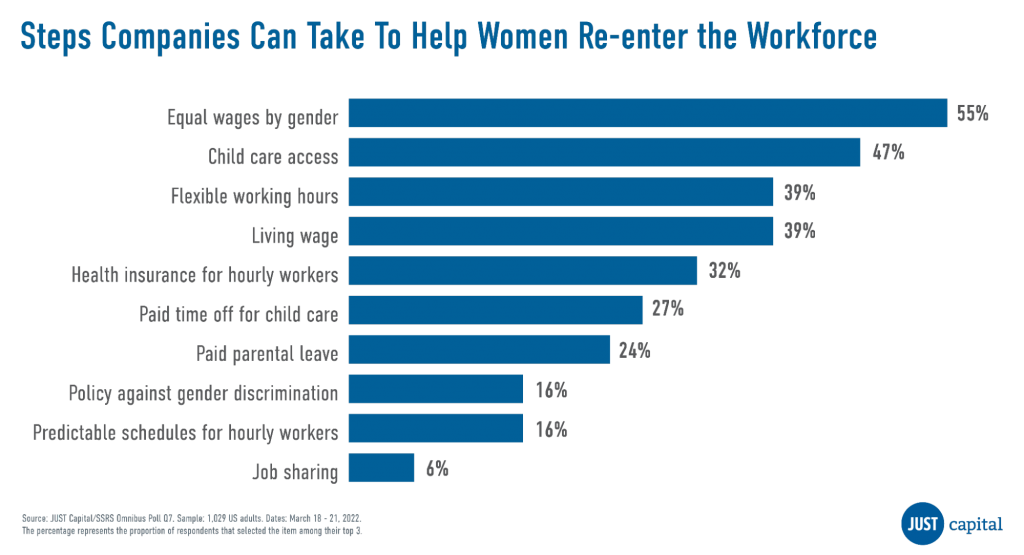
The Challenges of Child Care
Difficulties in obtaining adequate child care have been cited as a key driver in women leaving the workforce over the past two years. In our September 2021 survey, we found that 78% of Americans would support a federal policy requiring employers to provide up to 12 weeks of paid leave for workers who need to take care of a sick spouse, child, or parent. But until this – or another – solution is reached, it will remain a considerable challenge to bring women with children back into the workplace.
These challenges have opened our eyes to the fact that it can no longer be the sole responsibility of parents to obtain childcare. When asked which institutions should share the responsibility with parents, more than half (52%) of Americans believe both government and employers have a responsibility to support parents in accessing affordable, quality childcare in their communities. What is more, a similar percentage (53%) believes that there should be a hybrid approach to paid leave, with both the government and private sector offering solutions.
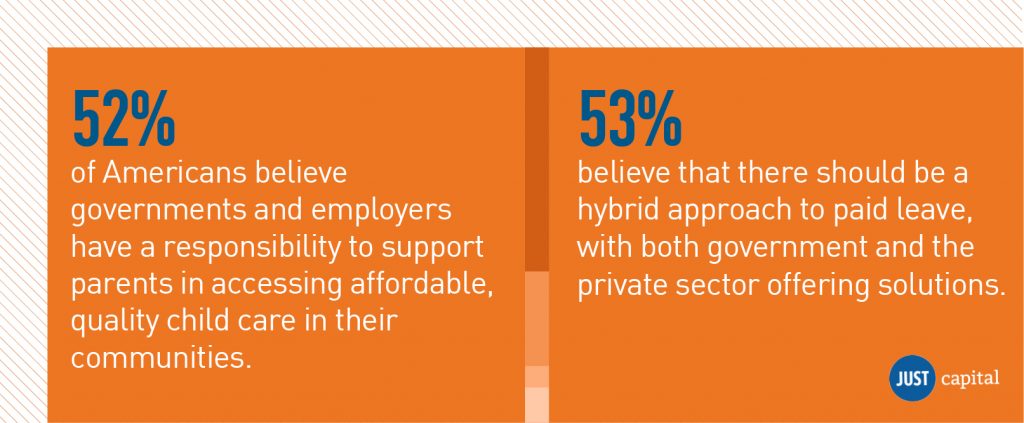
Childcare challenges extend to parental leave as well. Studies have shown that adequate paid leave for both parents yields multiple personal and economic benefits, from supporting early childhood development, family economic security, and ensuring that employees are able to remain in the workforce.
Americans have different opinions when it comes to the number of weeks they believe is ideal for paid parental leave. When asked for the ideal number of weeks for paid parental leave, Americans are split, with around half (48%) saying under 12 weeks and half (51%) saying 12 weeks or more.
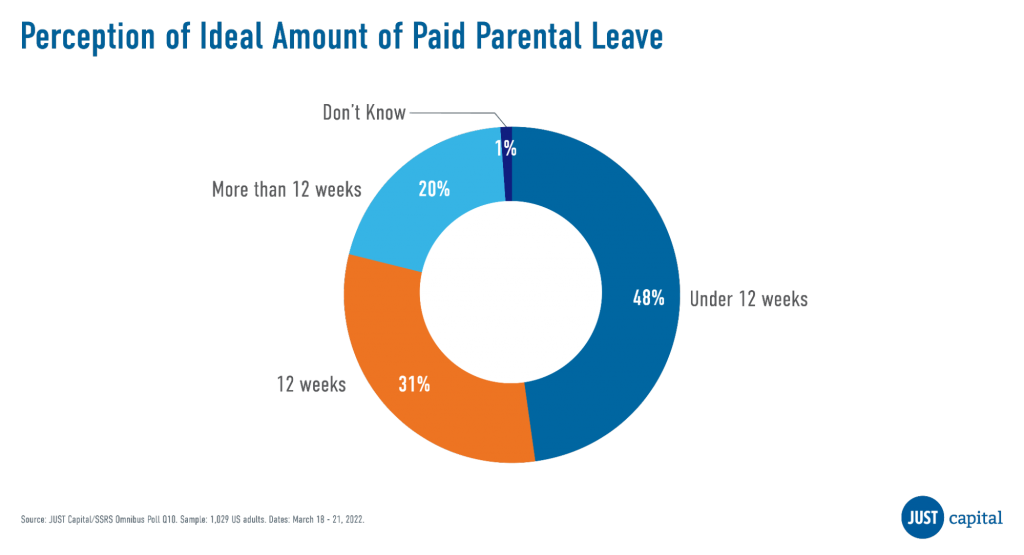
Majorities of Americans believe that, if companies offer the number of weeks they identified as ideal for paid parental leave, there would be a positive impact on gender equality in the home (60%), gender equality in the workplace (57%), and women’s advancement in the workplace (56%).
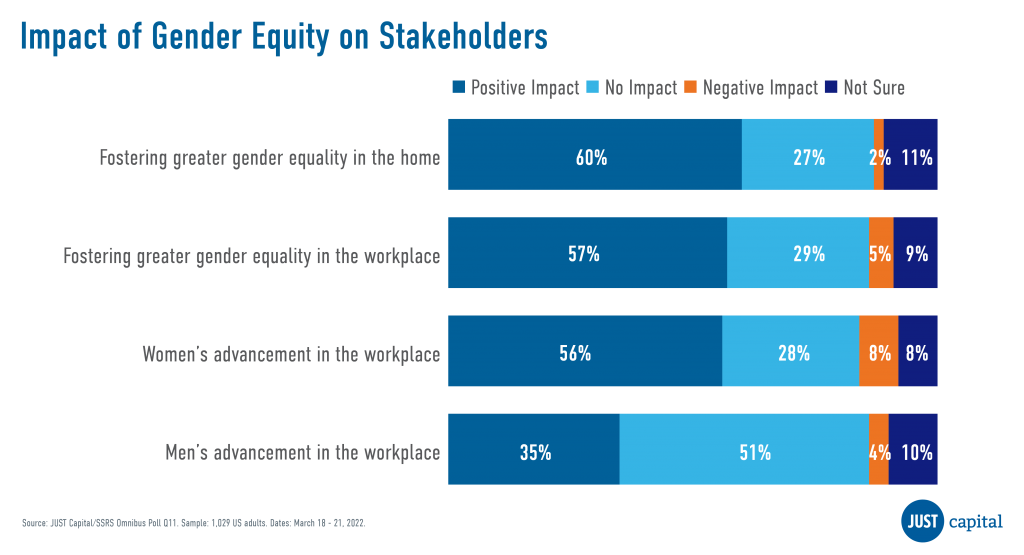
As our economy continues to find its footing coming through the pandemic – and as new challenges to economic stability arrive on the global stage – the persistent issues women have faced at work for decades only become more urgent. Americans agree that women face an uphill battle in the workplace, and that companies can and must do more. Some key steps for companies looking to advance gender equity in their organization include:
- Provide support to working parents. With many Americans having experienced or know someone who has experienced child care challenges, there are many actions companies can take to help working parents today – from providing flexible work schedules and paid caregiving leave to supporting then in the process to find child care services. And offering equal, substantial paid parental leave to both parents provides key benefits to both families and employers.
- Ensure fair and equal wages and quality benefits. With only 23% of the largest U.S. companies analyzing their gender pay gaps, corporate America has aways to go in ensuring that women and men receive equal pay for equal work. Benefits are important too – paid sick leave and flexible scheduling provide important pathways for working parents to have work-life balance.
- Create strong workplace protections for harassment and discrimination. In the years following the #MeToo movement, this issue remains powerfully important for companies to continue to prioritize. Americans agree it’s one of the top issues women face in the workplace today, and providing transparent pathways for reporting is a key step corporate leaders can take to build a safer, more inclusive working environment.
In March, about 200,000 women joined the workforce – a heartening increase from the prior month’s numbers, which suggested it could still take another 10 months for women to recoup jobs lost during the pandemic, rather than four. The months ahead may yield more jobs for women, but companies looking to hold onto those women must continue building toward an inclusive workplace that ensures gender equity for all.
Methodology
This survey was conducted online within the United States by SSRS on behalf of JUST Capital. The survey fielded from March 18 to March 21, 2022. SSRS interviewed a representative sample of 1,029 U.S. adults (age 18 or older) for this survey from among its online Opinion Panel, a nationally representative, geographically diverse and probability-based web panel reaching respondents in all 50 states.
The margin of error is +/- 3.8% at a 95% confidence level. Results were weighted to U.S. Census parameters for age, gender, education, race/Hispanic ethnicity, Census Division and specifically surrounding party identification in order to ensure representativeness of the U.S. population. All margins of error include “design effects” to adjust for the effects of weighting. To see the topline results, question wording, and demographic breakdowns by question, please see here. For complete survey methodology, including weighting variables and subgroup sample sizes, please contact jmizell@justcapital.com.